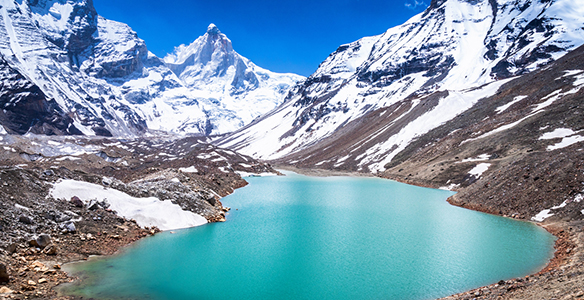Millions of farmers depend on meltwater from Himalaya glaciers


The faster melting of glaciers in the Himalayas in recent years will affect the crop production and livelihoods of around 129 million farmers who depend on meltwater from these glaciers, new research published in Nature Sustainability today reveals.
The researchers, including Christian Siderius of the Grantham Research Institute at the London School of Economics and Political Science, analyzed how meltwater mixes with rainfall and groundwater when propagating downstream and how it is subsequently distributed through the irrigation systems.
With over 900 million inhabitants, the South Asian river basins of the Indus, Ganges and Brahmaputra are amongst the world’s most densely populated areas. To a large extent, water supply in these areas depends on melting glaciers and snow from the Himalaya. Meltwater is used for crop irrigation and provides farmers with sufficient water in periods of drought and minimal rainfall.
The study shows that 129 million farmers (partly) irrigate their land using water originating from snow and glaciers in the mountains. Meltwater alone provides enough water to grow food crops to sustain a balanced diet for 38 million people.
Dependence is largest in the Indus basin, where the agricultural areas see little rainfall and therefore rely on other water sources. In the dry season up to 60% of the total irrigation withdrawals originate from mountain snow and glacier melt. The dependence in the floodplains of the Ganges is comparatively lower, but incoming meltwater is still an essential source during the dry season – in particular for crops like sugarcane.
“Millions of people are in danger of losing their livelihoods and their sources of food due to the fast melting of the Himalayan glaciers,” said Christian Siderius, co-author of the paper and research fellow at the Grantham Research Institute on Climate Change and the Environment at the London School of Economics and Political Science. “With an issue of this scale there is a clear need for political cooperation to ensure that these people are not pushed into poverty by global warming. Rainwater harvesting, improving man-made reservoirs or increasing groundwater use where possible might offset some of the loss or shift in meltwater, but these strategies are not sufficient. Governments will need to think about food security strategies for dependent communities and further studies looking at the changing supplies of water as a resource in South Asia must take into account socio-economic developments alongside those affected by climate change, such as melting glaciers and snowpacks, changes in monsoon rainfall, and groundwater depletion.”
“The Indus and Ganges basins have complex irrigation systems consisting of canals to transport water to the agricultural fields, sometimes over hundreds of kilometers”, Hester Biemans, researcher at Wageningen University & Research and lead author of the paper explained. “This research shows for the first time to what extent irrigation systems are fed with meltwater, how meltwater contributes to crop production, in which period it is most crucial and for which crop. We found that mainly the production of rice and cotton strongly depends on the timely availability of snow and glacier melt water.”
Previous research showed that a third of the total ice volume in the Himalaya might have disappeared by the end of the 21st century, with another study just last month showing that in the past 20 years, glaciers in the Himalaya were melting at a higher rate than in years before.
Considering the accelerated melting process and the increasing unpredictability of the monsoon, the researchers emphasised that farmers will need to adapt their practices to these changing circumstances. “Farmers might need to adjust their sowing dates or change to crops that require less water,” Biemans explains. “Cotton is a water-demanding crop that is sown during the driest months of the year. It might be better to grow cotton in areas with more water available. But this is mainly a political choice. The findings of this study can provide policy makers with quantitative information needed to support these kind of choices.”
This study was conducted as part of the large project Hi-Aware on climate change adaptation in the Indus, Ganges and Brahmaputra river basins. Follow-up research will focus on the future, the importance of meltwater for agriculture in a changing climate, and the search for appropriate adaptation strategies and potential solutions for an emerging water crisis.
For more information about this media release please contact Kieran Lowe on +44 (0) 20 7107 5442 or k.lowe@lse.ac.uk or Bob Ward on +44 (0) 7811 320346 or r.e.ward@lse.ac.uk.
NOTES FOR EDITORS
- The ESRC Centre for Climate Change Economics and Policy (https://www.cccep.ac.uk/) is hosted by the University of Leeds and the London School of Economics and Political Science. It is funded by the UK Economic and Social Research Council (https://www.esrc.ac.uk/). The Centre’s mission is to advance public and private action on climate change through rigorous, innovative research.
- The Grantham Research Institute on Climate Change and the Environment (https://www.lse.ac.uk/grantham) was launched at the London School of Economics and Political Science in October 2008. It is funded by The Grantham Foundation for the Protection of the Environment (https://www.granthamfoundation.org/).
-ENDS-

